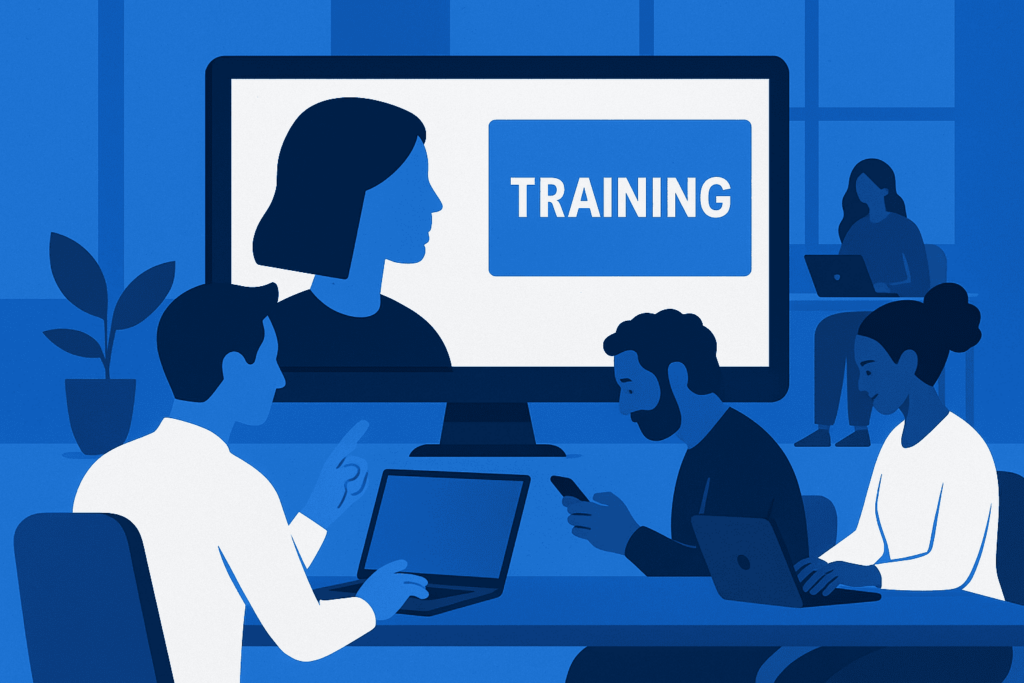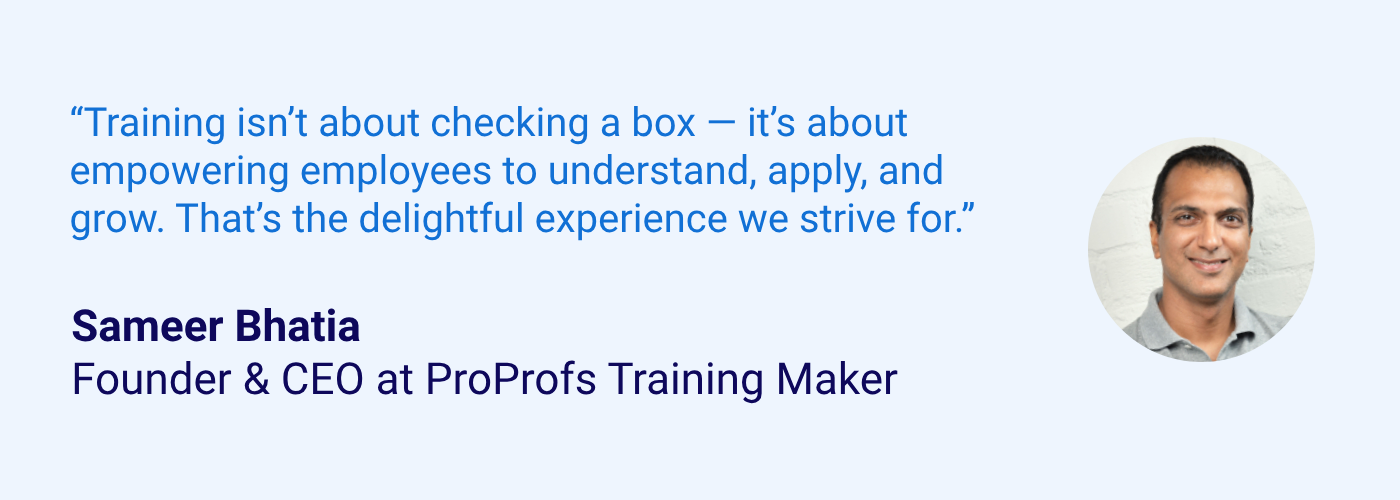A new survey of U.S. workers reveals engagement challenges and a growing demand for effective training solutions, with two-thirds willing to quit due to a lack of upskilling opportunities.

Would you quit your job over inadequate training? Two-thirds of U.S. workers say yes, rising to nearly 80% among Gen Z. With 60% of companies operating in a hybrid work environment, and AI reshaping how people learn, employee expectations for development are growing fast. Training is being evaluated not just by what it offers but by how effectively it fits into the way people work today.
To understand how these shifts are playing out, we surveyed 1,000 full-time U.S. employees across industries and age groups. The findings reveal a workforce grappling with distractions, generic training programs, and limited time for focused learning, alongside a growing interest in more innovative and adaptive solutions. From preventable mistakes to resume inflation, the data offers a clear snapshot of how training trends are shaping the future of work.
Key Takeaways
- Out of the 1,000 respondents, 66% of workers would actively seek a new job if their employer didn’t offer upskilling, rising to 79% among Gen Z.
- One in three workers say their company’s training is outdated or too generic, and 36% have misrepresented their training experience on job applications.
- 45% have made mistakes due to poor training, and 26% admit to scrolling social media during sessions.
- Only 18% receive dedicated time from employers to focus during training, while 82% multitask, with 34% guessing on quizzes and 31% skipping ahead to finish faster.
- 38% have completed AI-powered training, and 76% say it improved their job performance.
- Video modules (53%) are considered the most effective format, followed by live virtual sessions (38%), interactive eLearning (33%), and in-person training (32%).
Upskilling Expectations vs. Reality
Professional development isn’t a perk — it’s a dealbreaker. Workers are increasingly recognizing the importance of training for their professional growth and job security, particularly in a rapidly evolving economy. When opportunities to upskill are scarce, so are tenured employees.
However, not all employees feel the same about this distinction. In particular, there seems to be a generational divide, with nearly four in five Gen Z workers (79%) willing to actively seek new opportunities if denied upskilling, compared to 72% of Millennials, 58% of Gen X, and 45% of Boomers. For younger respondents, professional development isn’t necessarily just about advancing their careers. For them, it’s keeping their job secure in a rapidly changing economy.
Even if employees work in an environment with professional development programs, the training programs may need a significant refresh. One in three employees says their workplace only has professional development training programs so employees can “check a box,” or they haven’t kept up-to-date with the latest changes in industry-specific tools, technology, and workflows. When companies fail to modernize, they open the door for competitors to attract talent with stronger development opportunities.
The cracks show even more clearly in how workplaces deliver their training. Nearly a quarter say it’s too generic or not tailored to their role, and 21% struggle to apply what they’ve learned on the job. Workers want to grow, but when training falls short, especially for younger generations with high expectations, companies risk losing them.
Distracted Learning: When Training Competes with Everything Else
Even if an employer provides adequate training programs for its employees, many fail to recognize the value of the time it will take. As a result, many employees don’t dedicate their undivided attention to training programs due to multitasking.
Only 18% of workers receive dedicated time to focus on their training programs from their employers. In comparison, the rest are expected to multitask—either by juggling responsibilities (49%) or feeling implicit pressure to handle other tasks even when it’s not explicitly required (33%).
This divided focus shows up in how people engage — or disengage — with learning. More than a third (34%) say they’ve guessed on quizzes without watching the material, 31% skip ahead or fast-forward, and 28% use AI tools to find answers. One in four (24%) scroll social media while sessions play in the background, and 26% admit to tuning out entirely.
These actions directly contradict the cognitive psychology that goes into workplace education. To properly retain information and grow in their careers, employees need to take their time in learning new information, take low-stakes quizzes more sporadically throughout a given period, take notes, teach others, and receive feedback from others. Employees aren’t necessarily indifferent to their professional development. Previous results from our survey indicate the opposite, in fact. These findings simply indicate that employers need to factor in how much time, energy, and methods employees need to develop themselves.
That said, our findings also discovered that the younger the worker, the more likely they are to check out. Gen Z leads in passive distraction, with 34% admitting to daydreaming during training, compared to 28% of millennials, 21% of Gen X, and just 17% of boomers. These trends highlight a growing mismatch between how training is delivered and how today’s employees — especially digital natives — are wired to learn. Younger generations may need more digitally-centered, engaging training, while older generations may appreciate receiving material in person.
When Training Gaps Lead to Real-World Mistakes
Disengagement isn’t just about attention lapses. It can lead to real-world consequences. Not all workplace mistakes come from inexperience. Many stem from training that doesn’t match the realities of the job.
Nearly half of employees (45%) say they’ve made a mistake at work because the training they received was unclear, outdated, or incomplete. For 8%, those mistakes had serious consequences. Another 12% said they narrowly avoided errors by turning to a coworker, AI tools, or quick online searches to fill in the gaps.
Overall, 57% of workers have either made or nearly made a mistake because their training didn’t adequately prepare them. Only 43% believe their training was sufficient. The rest are often left to improvise or rely on peers to compensate for what formal instruction failed to provide.
Younger employees appear to feel this gap more acutely. Gen Z and millennials were the most likely to report real-world mistakes tied to insufficient training, both because they’re earlier in their careers and because they’ve come to expect training to be fast, digital, and directly applicable. Without that, performance suffers — and so does their trust in the system.
Misrepresentation in Job Applications and the Evolving Role of AI in Training
Training doesn’t just impact performance — it influences how employees present themselves when applying for new roles. More than one in three workers admit to misrepresenting their training experience on job applications. The most common move? Overstating their understanding of the material (25%), followed by claiming to have completed training they never actually finished (11%).
This disconnect raises essential questions for employers. As training becomes more digital and less observable, how do hiring managers verify what candidates learned? The answer may lie in better systems, not just better trust.
They need better ways to verify potential candidates’ qualifications, whether that includes evaluating their certifications and previous work experiences, or checking in with a reliable reference.
Once employers hire candidates for the role, however, they have differing methods to deliver training, with a growing percentage relying on AI. While 37% of employees report that their workplace doesn’t use AI in training at all, the rest describe a mixed landscape: 28% use AI informally, 27% say it’s part of structured programs, and 8% say AI has entirely replaced traditional training methods.
This diversity in approaches shows there’s no clear standard yet — and as AI becomes more embedded in workplace learning, the lines between real comprehension and tech-enabled workarounds may get even blurrier. Younger workers, in particular, are slightly more likely to admit misrepresentation, possibly reflecting greater comfort with tech-assisted learning.
Get Free Employee Training Software — All Features, Forever.
We've helped 567 companies train 200,000+ employees. Create courses in under a minute with our AI LMS or use 200+ ready-made courses on compliance, harassment, DEI, onboarding, and more!
AI Training Revolution—Promise vs. Performance Across Generations
Artificial intelligence is reshaping workplace training, but the reality of implementation reveals both significant potential and notable challenges. While AI-powered training shows measurable benefits for those who use it, adoption patterns vary dramatically across demographic groups, creating both opportunities and divides.
To better understand how employees experience AI training, we looked at who’s using it — and how well it’s working. Currently, 38% of workers have experienced AI-powered training, but adoption varies significantly by generation: 64% of Gen Z workers have used AI-enhanced training compared to 45% of millennials. Gender differences are also notable, with 42% of men having used AI training compared to 34% of women, suggesting that employers must consider multiple demographics before implementing permanent training strategies.
Among those who have used AI-powered training, the results are mainly positive: 76% report it helped them perform better at their jobs, with 33% saying it definitely helped and 43% reporting somewhat positive impacts. Only 1% found AI training made things worse, while 23% noticed no impact. This effectiveness spans across age groups, suggesting that when properly implemented, AI training can benefit workers regardless of generation.
However, the technology faces real implementation challenges that vary by user experience and demographic. Among AI training users, 32% encountered wrong or outdated information, 27% found it too generic for their roles, and 26% reported confusion or misleading content.
Additionally, 17% experienced unclear or contradictory guidance. Despite these issues, 34% of AI training users experienced no problems at all, indicating that the quality and relevance of AI training vary significantly across different programs and may require more sophisticated personalization to address generational and role-specific needs.
Rebuilding Training for the Future of Work
Today’s workforce values development, but many current training systems aren’t keeping pace with evolving needs. Outdated delivery methods and surface-level metrics often miss the deeper goal — engaged, practical learning that supports both retention and performance.
As roles shift and technology reshapes how we work, training must do more than check a box. It needs to prepare employees to succeed in fast-moving, digitally connected environments.

This means rethinking how learning is delivered, utilizing AI with intention, and creating systems that verify genuine understanding, not just participation. The future of workplace training depends on tools that earn attention, deliver relevance, and build trust.
For organizations ready to meet the moment, the opportunity to strengthen training and workplace outcomes starts now.
Methodology
This study surveyed 1,000 full-time U.S. workers across multiple industries and work environments in June 2025. We balanced participants by age, gender, and employment status to ensure the representativeness of the findings. All responses are self-reported, and percentages may not total 100% due to rounding.
About ProProfs Training Maker
ProProfs Training Maker is delightfully easy training software for your employees. Create a course in minutes using AI or choose from 500+ ready-to-use, expert-taught courses to automate compliance and skill training.
Customize content to match your team’s needs, track progress effortlessly, and deliver training that’s simple to launch and engaging to take. The platform helps you move beyond checkbox training by making it easier to deliver relevant content and measure real progress.
Fair Use Statement
You are welcome to cite or republish these findings for noncommercial use with proper attribution. Please credit ProProfs Training Maker and include a link to the complete study.


 We'd love your feedback!
We'd love your feedback! Thanks for your feedback!
Thanks for your feedback!



